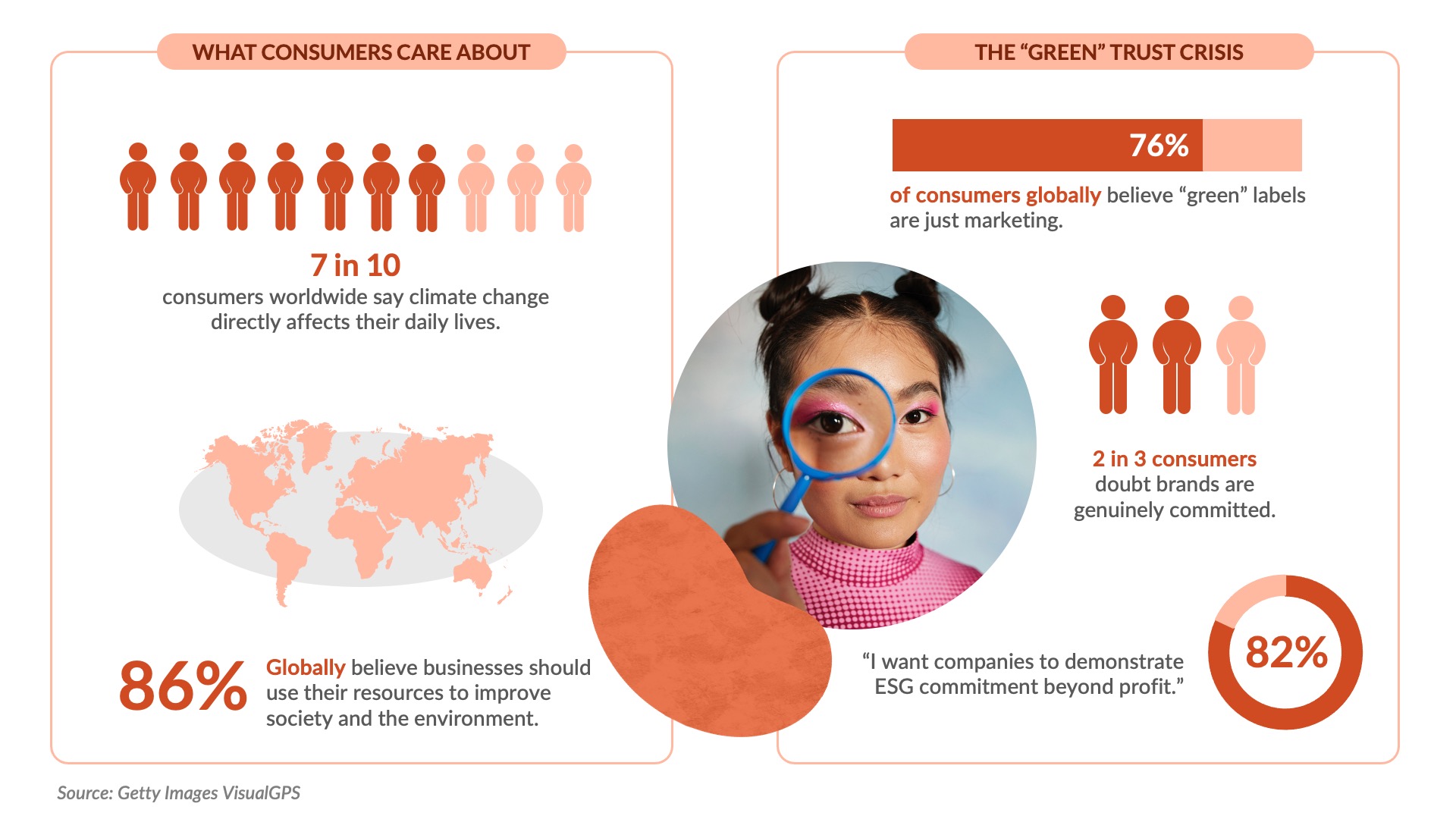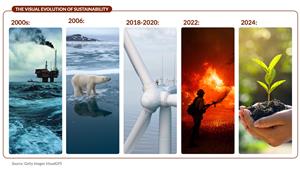New Getty Images Report Finds Consumers Still Care About Sustainability and Expect Businesses to Lead

Getty Images’ “Sustainability at the Crossroads” report provides visual guidance grounded in consumer insights to support companies in aligning their communications with business actions.
- Sustainability is still top of mind: 69% of global consumers say climate change directly affects their daily lives.
- Brands are expected to lead: 86% of consumers believe businesses should use their resources to improve society and the environment.
-
Visuals make or break trust: Consumers demand imagery that reflects real impact.
NEW YORK, June 12, 2025 (GLOBE NEWSWIRE) -- Getty Images (NYSE: GETY), a preeminent global visual content creator and marketplace, has today released the latest report from its VisualGPS global insights platform - Sustainability at the Crossroads. This study maps out the latest consumer sentiment around sustainability and offers actionable insights and data-driven guidance to help brands communicate CSR commitments with authenticity, clarity, and impact in a rapidly evolving media landscape.
With the report finding 69% of consumers worldwide recognize the direct impact climate change currently has on their daily lives, the issue is becoming an increasingly personal reality. Amid this growing awareness and as the issue takes center stage in public discourse, some brands and organizations are treading carefully in how they communicate their efforts or if they do so at all. A response aligned with the trend of “greenhushing”.
Visual analysis in the report traces this evolution: from symbolic imagery like polar bears in 2006, to stark, real-world depictions of climate impacts such as floods, fires, and displacement around 2018–2022. More recently, the trend has shifted from clarity to conceptual representation, with brands adopting abstract visuals signaling sustainability without making direct claims. However, research suggests that staying silent may carry its own risks: nearly 9 in 10 consumers worldwide believe businesses should use their resources to improve society and the environment.

At the same time, skepticism is rising: 76% of consumers worldwide question the credibility of brands’ environmental claims, and 2 out of 3 globally doubt that companies are genuinely committed to sustainability. As pressure builds around accountability, the report underscores the need for brands to communicate with clarity, backing up ESG strategies with visual storytelling that is authentic and aligned with real-world impact.

“What years of studying sustainability imagery has shown me is that the commercial focus on sustainability surges in times of cultural urgency and recedes in moments of economic pressure or shifting priorities,” said Dr. Rebecca Swift, Senior Vice President of Creative at Getty Images. “We are now in that period of pull back, but this new VisualGPS research tells us that consumer expectations are louder and more urgent than ever. People want to see real action, and they want to believe in the impact they are seeing. Visual storytelling is a key vehicle for answering this call.”
As climate risk becomes increasingly tied to business risk, the report supports brand leaders, marketers, and communicators in aligning their visual narratives with their strategic sustainability goals. Key insights from the report include:
- Authenticity over perfection: 81% of consumers want to see visuals that show how the environment is being affected as a direct result of climate change, favoring transparent and realistic imagery that shows both progress and challenges over idealized or symbolic depictions.
- Balance eco-anxiety with eco-optimism: 78% want to see how things are improving—whether through individual, corporate, or policy-driven action. Powerful storytelling should blend impactful imagery with tangible actions, showing both environmental challenges and proactive solutions.
- Highlight the potential of new technologies: 83% of consumers believe AI could positively impact the climate crisis within the next five years. However, concerns about AI’s carbon footprint are real. Only 41% see AI as having a positive impact on energy efficiency. As generative AI continues to grow, its environmental impact should be considered when visualizing technology. Brands can leverage visuals that have a deep focus on the benefits and real-world impact of all technological innovation to inspire trust and drive engagement.
- Make sustainability accessible: 81% want to see images and videos that reflect how people have been personally affected—especially those in the communities most impacted. Inspire action with relatable visuals that highlight simple, everyday habits, reinforcing that sustainable choices can seamlessly fit into daily life for all.
-
Show integration, not isolation: 75% of consumers want to see visuals showing how companies and governments are addressing climate change, not just in isolated campaigns. Show sustainability as a core brand value. Companies that seamlessly embed sustainability into their identity—through product design, messaging, and customer experience, when backed by honest, unambiguous visuals, will foster deeper emotional connections and lasting trust with consumers.
To download the full Getty Images’ VisualGPS report, Sustainability at the Crossroads, click here.
Image credits: Artur Debat/Getty Images
Methodology:
Getty Images’ VisualGPS Reports offer unparalleled visual and creative intelligence backed by a rigorous methodology that combines visual insights from over 60 visual content and advertising experts with cultural insights, proprietary search and download trends from Getty Images and iStock (+ 2.8 billion searches each year), and consumer perspectives from ongoing global consumer surveys covering over 250 topics. In partnership with a world‑class global research firm MarketCast, this research platform has been tracking shifts in consumers’ needs consistently over the past six years. Data for the “Sustainability at the Crossroads” report was gathered through global VisualGPS consumer surveys conducted between July 2022 and July 2024. The research included adults aged 18 and above, with survey sample sizes ranging from 5,300 to 7,000 respondents. The research covered 25 countries, including Australia, Brazil, France, Germany, Italy, Japan, Spain, Singapore, the UK, US, and others.
Media contact:
Ilse Noguez
ilse.noguez@gettyimages.com
Photos accompanying this announcement are available at
https://www.globenewswire.com/NewsRoom/AttachmentNg/3ac83ba6-0ce1-4cf0-83d7-43bfa07cb643
https://www.globenewswire.com/NewsRoom/AttachmentNg/ccbb2cba-543e-4123-adcd-759340c9318c
https://www.globenewswire.com/NewsRoom/AttachmentNg/f578d92c-5800-4cf1-a418-def752646fe0

A large amount of plastic bales waiting in the outdoor of the recycling plant ready to be processed for a green circular economy with zero waste in Spain.
Artur Debat/ Getty Images
Source: VisualGPS
The Visual Evolution of Sustainability
Source: VisualGPS
Consumers Are Clear: Sustainability Still Matters in 2025
Legal Disclaimer:
EIN Presswire provides this news content "as is" without warranty of any kind. We do not accept any responsibility or liability for the accuracy, content, images, videos, licenses, completeness, legality, or reliability of the information contained in this article. If you have any complaints or copyright issues related to this article, kindly contact the author above.




